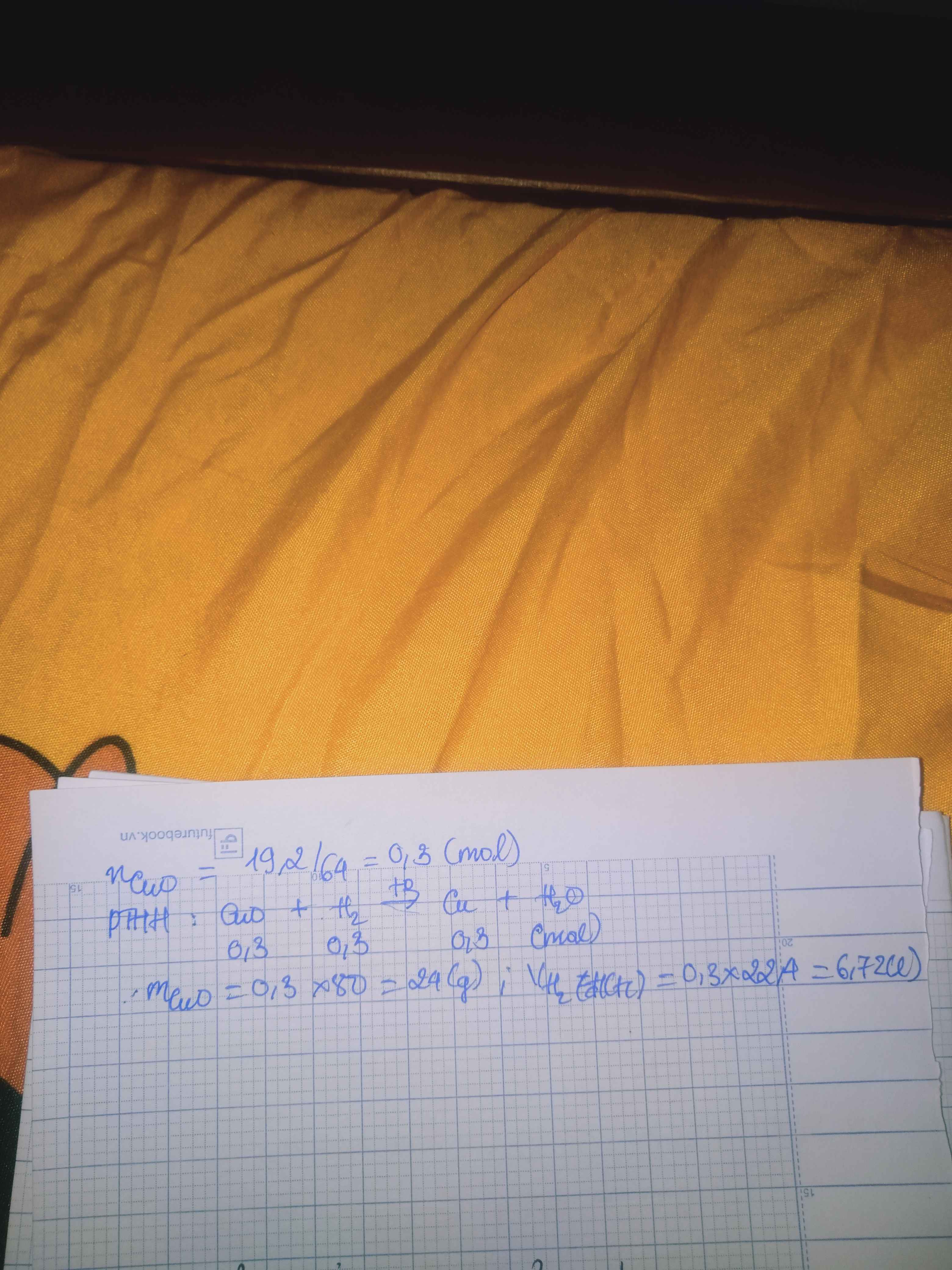Hãy nhập câu hỏi của bạn vào đây, nếu là tài khoản VIP, bạn sẽ được ưu tiên trả lời.

a, PT: \(CuO+H_2\underrightarrow{t^o}Cu+H_2O\)
b, \(n_{H_2}=\dfrac{2,479}{24,79}=0,1\left(mol\right)\)
\(n_{CuO}=\dfrac{12}{80}=0,15\left(mol\right)\)
Xét tỉ lệ: \(\dfrac{0,15}{1}>\dfrac{0,1}{1}\), ta được CuO dư.
Theo PT: \(n_{H_2O}=n_{H_2}=0,1\left(mol\right)\Rightarrow m_{H_2O}=0,1.18=1,8\left(g\right)\)
c, BTKL, có: mH2 + mCuO = m chất rắn + mH2O
⇒ a = 0,1.2 + 12 - 1,8 = 10,4 (g)

nCuO=12/80=0,15(mol)
nH2=2,24/22,4=0,1(mol)
a) PTHH: CuO + H2 -to-> Cu + H2O
Ta có: 0,15/1 > 0,1/1
-> CuO dư, H2 hết => Tính theo nH2
b) Ta sẽ có: nCu= nCuO(p.ứ)=nH2O= nH2=0,1(mol)
=> mH2O=0,1.18=1,8(g)
c) nCuO(dư)=0,15 - 0,1= 0,05(mol)
m(rắn)= mCu + mCuO(dư)= 0,1.64 + 0,05.80= 10,4(g)
=>a=10,4(g)
Số mol của khí hidro ở dktc
nH2 = \(\dfrac{V_{H2}}{22,4}=\dfrac{2,24}{22,4}=0,1\left(mol\right)\)
Số mol của đồng (II) oxit
nCuO = \(\dfrac{m_{CuO}}{M_{CuO}}=\dfrac{12}{80}=0,15\left(mol\right)\)
a) Pt : H2 + CuO → Cu + H2O\(|\)
1 1 1 1
0,1 0,15 0,1 0,1
b) Lập tỉ số so sánh : \(\dfrac{0,1}{1}< \dfrac{0,15}{1}\)
⇒ H2 phản ứng hết , CuO dư
⇒ Tính toán dựa vào số mol của H2
b) Số mol của nước
nH2O = \(\dfrac{0,1.1}{1}=0,1\left(mol\right)\)
Khối lượng của nước
mH2O = nH2O . MH2O
= 0,1. 18
= 1,8 (g)
Số mol của đồng
nCu = \(\dfrac{0,1.1}{1}=0,1\left(mol\right)\)
Khối lượng của đồng
mCu = nCu . MCu
= 0,1 . 64
= 6,4 (g)
Chúc bạn học tốt

Bài 1
a)\(2H2+O2-->2H2O\)
b)\(n_{H2}=\frac{2,8}{22,4}=0,125\left(mol\right)\)
\(n_{O2}=\frac{1}{2}n_{H2}=0,0625\left(mol\right)\)
\(V_{O2}=0,0625.22,4=1,4\left(l\right)\)
\(m_{O2}=0,0625.32=2\left(g\right)\)
c)\(n_{H2O}=n_{H2}=0,125\left(mol\right)\)
\(m_{H2O}=0,125.18=2,25\left(g\right)\)
Bài 2:
\(CuO+H2-->Cu+H2O\)
b)\(n_{CuO}=\frac{48}{80}=0,6\left(mol\right)\)
\(n_{Cu}=n_{CuO}=0,6\left(mol\right)\)
\(m_{Cu}=0,6.64=38,4\left(g\right)\)
c)\(n_{H2}=n_{CuO}=0,6\left(mol\right)\)
\(V_{H2}=0,6.22,4=13,44\left(l\right)\)
Bài 3:
a)\(2H2+O2-->2H2O\)
b)\(n_{H2}=\frac{1,12}{22,4}=0,05\left(mol\right)\)
\(n_{O2}=\frac{1,68}{22,4}=0,075\left(mol\right)\)
Lập tỉ lệ
\(n_{H2}\left(\frac{0,05}{2}\right)< n_{O2}\left(\frac{0,075}{1}\right)\)
\(\Rightarrow O2dư\)
\(n_{H2O}=n_{H2}=0,05\left(mol\right)\)
\(m_{H2O}=0,05.18=0,9\left(g\right)\)
Bài 4:
a)\(CuO+H2-->Cu+H2O\)
b)\(n_{CuO}=\frac{12}{80}=0,15\left(mol\right)\)
\(n_{H2}=2,\frac{24}{22,4}=0,1\left(mol\right)\)
do \(0,15>0,1\)
\(\Rightarrow H2\) hết..CuO dư
\(n_{H2O}=n_{H2}=0,1\left(mol\right)\)
\(m_{H2O}=0,1.18=1,8\left(g\right)\)
c) \(n_{CuO}=n_{H2}=0,1\left(mol\right)\)
\(n_{CuO}dư=0,15-0,1=0,05\left(mol\right)\)
\(m_{CuO}dư=0,05.80=4\left(g\right)\)
\(n_{Cu}=n_{H2}=0,1\left(mol\right)\)
\(m_{Cu}=0,1.64=6,4\left(g\right)\)

\(a,n_{H_2}=\dfrac{2,24}{22,4}=0,1\left(mol\right)\\ PTHH:2K+2H_2O\rightarrow2KOH+H_2\uparrow\\ Theo.pt:n_K=2n_{H_2}=2.0,1=0,2\left(mol\right)\\ m_K=0,2.39=7,8\left(g\right)\\ m_{K_2O}=17,2-7,8=9,4\left(g\right)\\ b,n_{CuO\left(bđ\right)}=\dfrac{12}{80}=0,15\left(mol\right)\\ PTHH:CuO+H_2\underrightarrow{t^o}Cu+H_2O\\ LTL:0,15>0,1\Rightarrow Cu.dư\)
Gọi nCuO (pư) = a (mol)
=> nCu = a (mol)
mchất rắn sau pư = 80(0,15 - a) + 64a = 10,8
=> a = 0,075 (mol)
=> nH2 (pư) = 0,075 (mol)
\(H=\dfrac{0,075}{0,1}=75\%\)

\(a.n_{CuO}=\dfrac{40}{80}=0,5\left(mol\right)\\ n_{H_2}=\dfrac{3,36}{22,4}=0,15\left(mol\right)\\ PTHH:CuO+H_2\underrightarrow{t^o}Cu+H_2O\\ Vì:\dfrac{0,15}{1}< \dfrac{0,5}{1}\\ \rightarrow CuOdư\\ n_{CuO\left(p.ứ\right)}=n_{Cu}=n_{H_2}=0,15\left(mol\right)\\ \rightarrow n_{CuO\left(dư\right)}=0,5-0,15=0,35\left(mol\right)\\ m_{CuO\left(DƯ\right)}=0,35.80=28\left(g\right)\\ b.m_{Cu}=0,35.64=22,4\left(g\right)\\ c.m_{hh_{rắn}}=m_{Cu}+m_{CuO\left(dư\right)}=22,4+28=50,4\left(g\right)\)

Zn+2HCl=>ZnCl2+H2
nZn=0,05 mol=nH2
H2+CuO=>Cu+H2O
=>nCu=0,05mol =>mCu=0,05.64=3,2g
Trong pứ trên Zn và H2 là chất khử
HCl và CuO là chất oxh
2. mNaCl thu đc=150.3,5%=5,25g
Cho 13gam Zn tác dụng với dung dịch HCL vừa đủ Dẫn toàn bộ khí thu được qua CuO nung nóng
a, Viết PT hoá học của CÁC phản ứng
b, Tính khối lượng Cu thu được sau phản ứng

Theo gt ta có: $n_{CuO}=0,1(mol)$
$CuO+H_2\rightarrow Cu+H_2O$
a, CuO từ màu đen bị khử dần thành màu đỏ đặc trưng của Cu
c, Ta có: $n_{Cu}=n_{CuO}=0,1(mol)\Rightarrow m_{Cu}=6,4(g)$
a) Sau phản ứng thì chất rắn màu đen chuyển thành chất rắn màu đỏ, có hơi nước tạo thành
b) \(CuO+H_2\rightarrow Cu+H_2O\)
c) \(n_{CuO}=\dfrac{8}{80}=0,1\left(mol\right)\)
Theo pt \(n_{Cu}=n_{CuO}=0,1\left(mol\right)\)
\(m_{Cu}=0,1.64=6,4\left(g\right)\)

a) Phản ứng
CuO + H 2 → t o Cu + H 2 O (1)
(mol) 0,3 0,3 ← 0,3
b) Ta có: n Cu = 19,2/64 = 0,3 (mol)
Từ (1) → n Cu = 0,3 (mol) → m CuO = 0,3 x 80 = 24 (gam)
Và n H 2 = 0,3 (mol) → V H 2 =0,3 x 22,4 = 6,72 (lít)

a) CuO + H2 -> Cu + H2O
b) nCuO = 0,15(mol) nH2 = 0,1 (mol)
=> CuO dư 0,05 (mol)
theo PTHH => nH2O = nH2 = 0,1 (mol)
=> mH2O = 0,1x 18=1,8(g)
c) theo pthh nCu = nH2 = 0,1 (mol)
=> mCu = 0,1x64 = 6,4(g)
mCuO dư = 0,05 x 80 =4(g)
Bài 2 :
nCuO =0,2(mol) nCu= 0,1875(mol)
CuO + H2 -> cu +h2o
có %H = (0,1875 : 0,2) x 100%= 93,75%
Bài 1 :
a, \(CuO+H_2\rightarrow Cu+H_2O\)
b,
\(n_{H2}=\frac{2,24}{22,4}=0,1\left(mol\right)\)
\(n_{CuO}=\frac{12}{80}=0,15\left(mol\right)\)
Tỉ lệ : \(\frac{0,15}{1}>\frac{0,1}{1}\)
Nên CuO dư
\(n_{H2O}=n_{H2}=0,1\left(mol\right)\)
\(\Rightarrow m_{H2O}=0,1.18=1,8\left(g\right)\)
c)
\(n_{CuO_{dư}}=0,15-0,1=0,05\left(mol\right)\)
\(m_{CuO}=0,05.80=4\left(g\right)\)
\(m_{Cu}=0,1.64=6,4\left(g\right)\)
Bài 2 :
\(n_{CuO}=\frac{16}{80}=0,2\left(mol\right)\)
\(CuO+H_2\rightarrow Cu+H_2O\)
0,2 _____________ 0,2
Ta có khối lượng Cu theo lí thuyết là:
\(m_{Cu}=0,2.64=12,8\left(g\right)\)
Khối lượng Cu thực tế là 12 g
\(\Rightarrow H=\frac{12}{12,8}.100\%=93,75\%\)